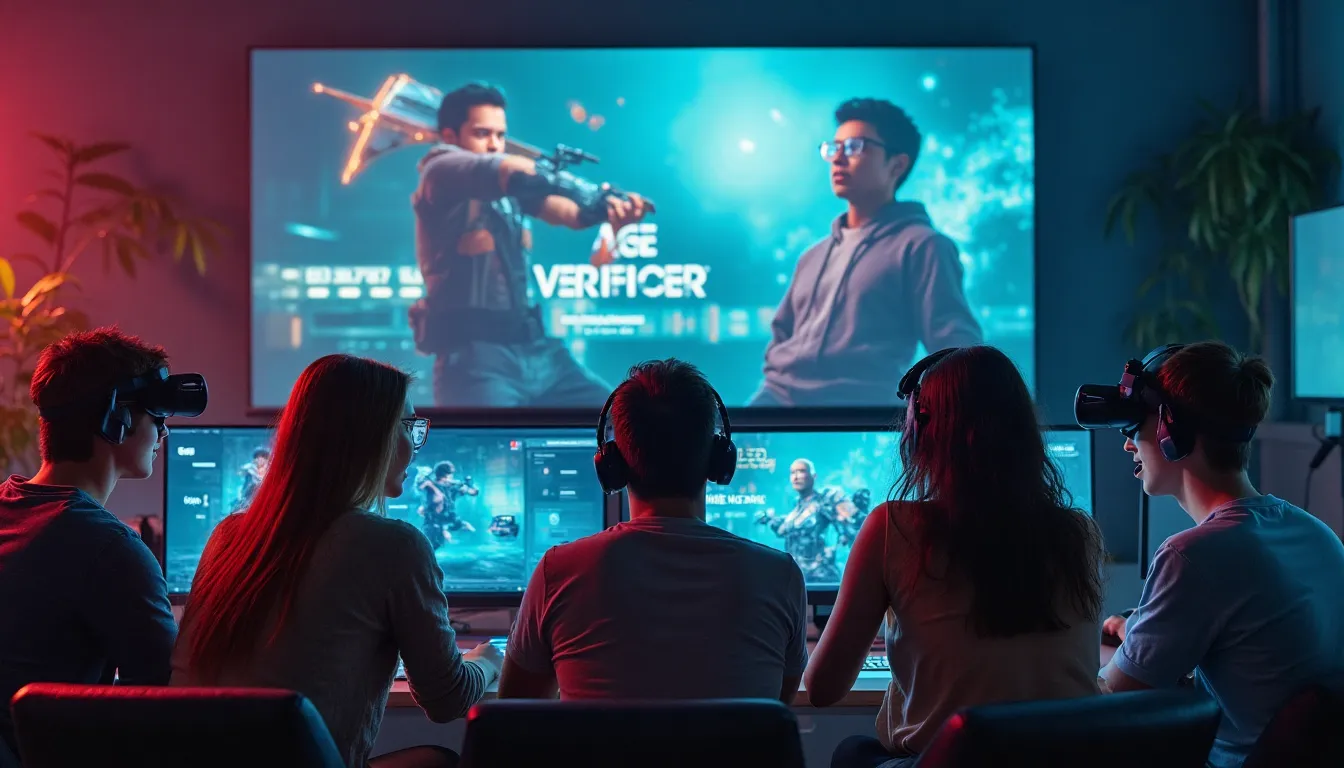In the rapidly evolving landscape of gaming, age verification technology is becoming an essential yet controversial topic. With the surge of AI-driven tools aimed at pinpointing the age of players, there comes a new layer of complexity and caution. Recent advancements in generative AI, particularly the proliferation of deepfake technology, present unique challenges. These AI-generated alternatives can manipulate visuals and identities, raising the risk of misidentification during verification processes. As gaming companies such as Discord and Google embrace these technologies to comply with age-related laws, critical scrutiny arises over the effectiveness and ethical implications of such measures.
The landscape is teetering on a precarious edge where privacy concerns and data security intersect. Yet, as we integrate AI systems into age verification, how prepared are we to combat these ingenious methods of deception? Striking a balance between safeguarding young users and imposing stringent regulations is no easy feat, and the quest for a reliable solution remains fraught with obstacles.
The stakes are high, and the ramifications of either failure or success will significantly shape the future of online gaming experiences. As we navigate this uncharted territory, a critical caution is warranted – are we merely pushing our youth into darker corners of the internet while attempting to protect them?
David Maimon once stated, “The process of age verification is complicated.”
This quote encapsulates the myriad challenges currently faced in the realm of AI-driven age verification, particularly in gaming. As AI technologies rapidly evolve, they create an intricate landscape for accurately determining the age of users. The challenges stem from multiple factors, including the adeptness with which young users can manipulate their identities online, especially through the use of deepfake technology.
This complexity not only complicates the implementation of reliable verification measures but also raises ethical concerns over privacy and data security. The consequences of inadequate verification can lead to significant implications for both users and game developers, pushing the industry into a debate over how best to protect vulnerable populations while maintaining a safe gaming environment.
In recent years, age verification technologies have gained significant traction within gaming platforms, primarily driven by regulatory requirements and heightened concerns over user safety. Platforms like Discord and Roblox have adopted these measures in response to evolving legal landscapes, notably regulations implemented in the UK and elsewhere. This section discusses the adoption trends, demographics, and user behaviors concerning age verification in these two prominent platforms.
Discord
As of July 2025, Discord has instituted mandatory age verification for users in the UK, requiring individuals to prove their age for accessing specific content. This new system employs various verification methods, including facial recognition and ID uploads. However, challenges persist, as many users have managed to circumvent these verification processes, prompting Discord to continually adapt its methods [TechRadar].
The demographic distribution of Discord users indicates that the majority belong to the young adult category, particularly those aged 25 to 34, who represent over 40% of the total user base [Distuts]. This suggests a higher likelihood of acceptance of age verification measures among users who are more mature than younger audiences.
Roblox
Conversely, Roblox has proactively integrated age verification systems to ensure that users who wish to participate in features like unfiltered chat must verify their age, typically through a video selfie analyzed for accuracy [Roblox]. As of 2025, Roblox reported significant growth in its user base, with monthly active users reaching 380 million and a notable increase of 16.5% compared to the previous year. Its age demographic is also aging, with individuals aged 17 to 24 constituting roughly 21% of active users—a clear shift toward maturity in the player base [TechPoint].
Moreover, Roblox has introduced AI-driven safety measures, further demonstrating its commitment to user protection. In the first half of 2025, their AI system, Sentinel, was involved in generating over 1,200 reports to the National Center for Missing and Exploited Children regarding potential predatory behavior [AP News]. This proactive stance underscores the platform’s focus on safeguarding its users while adapting to regulatory mandates.
💡 Sponsored: Build Custom AI for Gaming with n8n
Age verification is just one part of modern gaming innovation the real magic happens when you start automating. With n8n, you can build your own custom AI to enhance games and manage communication channels like Discord. Imagine creating a workflow where your AI verifies players, moderates chat, detects suspicious activity, and engages your community in real time without writing thousands of lines of code.
Get started fast: host n8n with n8n Cloud, one-click deploy on Railway, or run it on a reliable VPS via Hostinger for full control.
Not sure where to begin? Plug in my ready-made n8n workflows for AI-driven moderation and player engagement. With these tools, you’re not just running a game server you’re running an intelligent, automated gaming ecosystem.
Comparison
| Age Verification Method | Effectiveness | Privacy Concerns | User Acceptance |
|---|---|---|---|
| Face Scans | Moderate | High (data retention issues, misuse) | Mixed |
| Government ID Checks | High | Low (standardized checks) | High |
| Date of Birth Entry | Low | Moderate (user honesty issues) | High |
| Biometric Authentication | High | High (data handling risks) | Mixed |
| AI-Powered Verification | Moderate | High (model biases, inaccuracies) | Low |
As the landscape of digital interactions continues to evolve, privacy concerns surrounding age verification processes have emerged as a paramount issue in gaming. With increasing mandates for age checks, platforms are collecting vast amounts of personal data from users. This paradigm shift raises significant questions about user privacy, data security, and potential misuse of sensitive information.
One of the primary issues stems from security breaches that can lead to unauthorized access to personal information. High-profile incidents involving major companies have highlighted vulnerabilities in data protection, demonstrating that even the most trusted platforms are not immune to cyberattacks. For instance, hacking incidents can result in hackers obtaining sensitive user data, including identification information that could be exploited for identity theft or fraud.
Moreover, the process of collecting personal data for age verification extends beyond mere identification. Platforms often gather additional information that, while intended for safety and compliance, can inadvertently lead to data leaks. The balance between protecting minors by verifying their age and ensuring their personal information remains confidential is delicate and fraught with challenges. Experts like Antsy have voiced concerns regarding this dynamic, stating,
“I believe, though, that it should not be the internet’s job to parent and protect its younger users.”
This perspective underscores a fundamental issue: as verification processes become more intrusive, the risk of infringing on individual privacy escalates.
Additionally, the tools employed for age verification, including facial recognition technologies, come with their own set of ethical dilemmas. Privacy advocates argue that these technologies can lead to unwanted surveillance and profiling, thereby intensifying privacy concerns. Antsy further cautioned that stringent verification laws might simply push young individuals towards less regulated corners of the internet, where safety measures are lacking and exposure to harmful content can increase. This reflects a broader debate about how best to balance safety concerns with the fundamental rights to privacy as technology continues to evolve.
In conclusion, as the integration of age verification technologies becomes increasingly common, the privacy risks associated with these systems warrant serious consideration. Stakeholders must navigate the fine line between regulatory compliance and the necessity of preserving individual privacy in an era where personal data is both a valuable asset and a potential target.
User Perspectives on Age Verification
As age verification systems gain traction and implementation across various gaming platforms, users have voiced their concerns and skepticism regarding these methods. The complexity and effectiveness of age verification technologies, especially in light of evolving AI capabilities, have left many players feeling uneasy about their safety and the potential misuse of their data.
Ash, a long-time gamer, expressed doubt about the reliability of face scans for verification. “I don’t think that face scans are a useful way to verify age since people can easily look under their age and be incorrectly flagged as being under 18.” This skepticism highlights a broader concern about the accuracy of technology and whether it can truly ensure the age safety of users.
Similarly, Antsy articulated their feelings against the intrusion of age verification measures. They pointed out, “I believe, though, that it should not be the internet’s job to parent and protect its younger users.” This statement captures a prevalent sentiment among players, who feel that stringent regulations might discourage appropriate young user interaction in a digital space that is meant for freedom and creativity.
Furthermore, Antsy added a critical note about the consequences of such measures, stating, “All you are doing by putting these laws into place is pushing young people towards corners of the internet the government can’t police.” This perspective emphasizes a fear that regulatory efforts could inadvertently push marginalized users into less safe environments where the oversight is minimal, further complicating the ideal of protecting young users.
The continuous push for advanced verification systems raises critical questions about the balance between safeguarding minors and ensuring the privacy rights of all users. As players like Ash and Antsy continue to challenge these verification methods, the conversation around age verification technologies must evolve to address the genuine concerns of the gaming community, ultimately leading to a more balanced and respectful approach to user safety and privacy.
Regulatory Landscape for Age Verification in Gaming in the UK
The UK’s Online Safety Act 2023, effective from October 26, 2023, introduces comprehensive regulations affecting online platforms, including major players like Google and Discord. This legislation is aimed at protecting minors from harmful online content, thereby necessitating the implementation of robust age verification systems.

Age Verification Requirements
Under the Online Safety Act, online platforms are required to prevent children from accessing harmful content, including pornography and materials that promote self-harm. To comply, service providers must implement age verification technologies, such as facial recognition and ID checks. Non-compliance can lead to severe financial penalties, including fines up to £18 million or 10% of annual turnover, whichever is higher [Wikipedia].
Implications for Privacy and Data Security
While the intent of the legislation is to enhance child safety, it raises significant concerns regarding privacy and data security. The collection of sensitive personal data, such as biometric information or photo IDs, poses risks of potential security breaches. Critics argue that the law lacks detailed provisions for managing and protecting this data. Previous data incidents, including a breach affecting a significant number of UK MPs, highlight the vulnerabilities in current data protection protocols [Tom’s Guide].
Challenges in Implementation
The implementation of effective age verification processes presents several challenges:
- User Circumvention: The rise of VPNs has made it easier for users to evade age checks, complicating enforcement efforts [Financial Times].
- Balancing Privacy and Compliance: Companies like Discord have introduced age verification methods that prioritize privacy. However, these measures must be carefully managed to maintain user trust and ensure compliance with safety regulations [Discord].
- Technical Limitations: Developing age verification systems that are both accurate and respect user privacy remains a significant hurdle for platforms with large user bases.
In conclusion, while the Online Safety Act 2023 aims to create a safer online environment for minors, it imposes substantial challenges for gaming companies such as Google and Discord in terms of privacy, data security, and compliance. Navigating these new regulations will be crucial for their ongoing operations in the UK.
In summary, the implementation of age verification technology in gaming represents a critical juncture where child safety and privacy must find a delicate equilibrium. As platforms increasingly adopt AI-driven measures to verify users’ ages, the complexity surrounding these systems reveals numerous challenges. While ensuring that young players are shielded from inappropriate content is a noble endeavor, the methodologies often employed to achieve this aim raise significant ethical concerns regarding data security and individual privacy rights.
The risks associated with privacy breaches and identity theft underscore the urgent need for thoughtful and transparent solutions. Legislation like the UK’s Online Safety Act seeks to provide a framework for these practices, but as we have seen, it also introduces new dilemmas that can push vulnerable populations toward less regulated corners of the internet. The critical voices within the gaming community, such as those of Ash and Antsy, remind us that stringent measures may not only limit user freedom but could inadvertently foster environments where safety is compromised.
Ultimately, as age verification systems evolve, it is imperative that stakeholders engage in dialogues that prioritize both the welfare of minors and respect for user privacy. Striking this balance is not merely a technical challenge; it calls for a reevaluation of our approaches to digital interactions and a commitment to creating protection systems that empower rather than alienate. The future of gaming hinges on this careful calibration, where safety and freedom can coexist, fostering a healthy online environment for all.
Conclusion
The trends and demographics illustrated by Discord and Roblox reflect a growing acceptance and integration of age verification technologies in gaming. While challenges remain, particularly regarding evasion techniques employed by younger users, the overall direction leans toward enhancing the safety and security of online environments for all users, particularly the younger demographic.
Overall, these efforts showcase an industry pivot to balance compliance, safety, and user experience, amidst growing regulatory scrutiny

